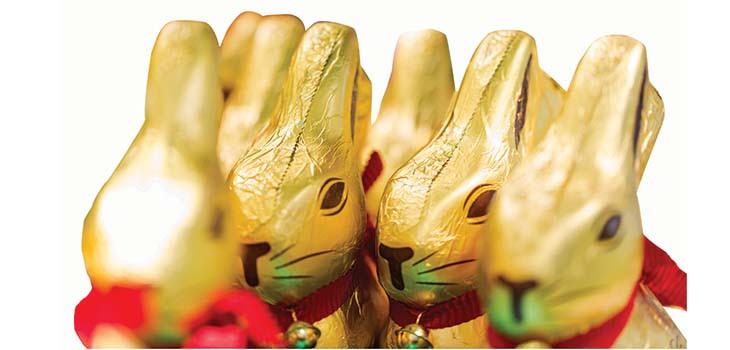
- Lindt won an infringement action against Lidl in the Swiss Federal Court in respect of their iconic ‘Goldhase’ chocolate bunnies, relying upon its registered EU 3D shape trade mark.
- Surveys adduced in evidence conducted on behalf of Lindt showed between 87% and 95% of respondents positively associated the 3D shape with Lindt.
- This judgment may serve as precedent in other jurisdictions; however, the courts of England and Wales have been generally reluctant to allow surveys to be adduced as evidence for trade mark infringement.
One of the main issues around bringing claims for passing-off or infringement of a trade mark against lookalike products is that it is often difficult to prove confusion on the part of the consumer. With trade mark infringement claims, this often involves trying to prove a ‘likelihood of confusion’ with the registered mark. The public often see lookalike products, but as long as they can differentiate the products it is hard to establish actual, or likely, confusion between them. This was one of the main themes in the case Lindt brought against Lidl; who would have expected to read about chocolate bunnies this close to Christmas?
On 30 August 2022, the Swiss Federal Court granted its judgment in which Lindt & Sprüngli were successful in enforcing their EU 3D shape trade mark against Lidl in respect of Lidl’s offending copies of the iconic gold bunny. Lidl must cease selling their chocolate bunnies and destroy any remaining stock; although, the judge pointed out that only the physical form of the chocolate must be destroyed, indicating that it could be melted down and re-used—this makes an order for destruction ‘proportionate’.
Background to the case
Since 2001, Lindt has held the EU 3D shape trade mark for its ‘Goldhase’ bunny: the gold-foiled chocolate bunny with a red collar and a bell. In 2018, Lindt began the process of bringing their case to the Swiss Commercial Court; however their demands were rejected last year. Upon appeal to the Federal Court, it was found that the Lidl’s bunnies trigger ‘obvious associations’ with the shape of Lindt’s and were therefore likely to be confused despite the differences between them.
Lindt has a strong history of defending its intellectual property, notably including its long legal dispute with rival chocolate maker Hauswirth who also previously made gold-wrapped chocolate rabbits with a ribbon collar, and its trade mark dispute over use of the mark ‘Lind’ by Lind Foods in 2015.
Of particular interest in the case brought against Lidl is the fact that surveys were relied upon and their results accepted by the court. Demoscopic surveys were carried out in which 1,209 Swiss people aged 15 to 74 were surveyed as a representative sample of the population. Respondents strongly associated the gold bunny with Lindt, with positive attributions ranging between 87% and 95%.
Position in this jurisdiction
In England and Wales, one of the following standard tests must be satisfied in order to claim infringement of your mark:
- it is an identical mark on identical goods;
- it is an identical mark on similar goods with a likelihood of confusion;
- it is a similar mark on identical or similar goods with a likelihood of confusion; or
- it is an identical or similar mark on any goods and:
- the registered mark has a reputation in the UK;
- use is without due cause and takes unfair advantage of, or is detrimental to, the distinctive character or reputation of the mark.
In the Lindt case it was a similar mark, ie a similar 3D shape of the Lidl bunny to the registered Lindt 3D shape mark, on identical goods—chocolate bunnies. Therefore, Lindt needed to prove a likelihood of confusion by consumers.
Likelihood of confusion is assessed by taking into account all relevant factors in the circumstances of the dispute. Courts will assess the visual, aural and conceptual similarity of the marks based on the overall impression given by the marks, bearing in mind their distinctive and dominant components (Sabel BV v Puma AG and Rudolf Dassler Sport (1997) C-251/95).
What is the effect of the Lindt case?
The courts of England and Wales are not obliged to follow the Swiss court’s reasoning or judgment, but they are likely to have been looking on with interest, and there is a possibility that it will serve as precedent in other jurisdictions as well. Our courts have been reluctant to admit survey evidence in recent decades, given the difficulty in ensuring the surveys are fairly conducted.
The reason for this is that it is very difficult to create a situation where members of the public spontaneously react to seeing the marks in actual use, which makes it challenging to gather credible evidence of confusion. There are numerous recent examples of the courts refusing to admit such evidence.
As the law continues to evolve in respect of trade mark infringement, particularly around this issue of likelihood of confusion, we look forward to seeing whether the ‘battle of the bunnies’ will be fought in the courts of England and Wales as well.
Louis Iveson, solicitor, and Laura Trapnell, head of IP, at Paris Smith Solicitors (www.parissmith.co.uk).












